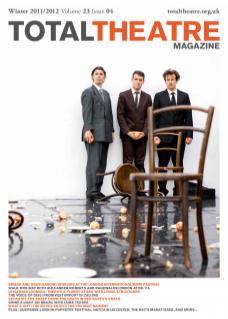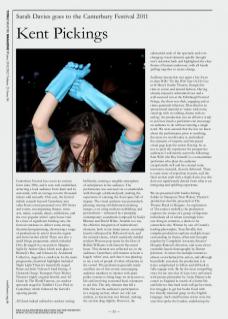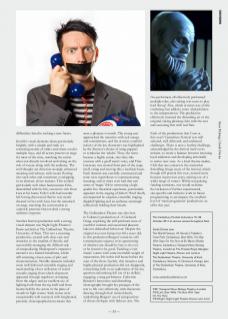Canterbury Festival has run in its current form since 1984, and is now well established, attracting a loyal audience from Kent and its surrounds, with an average seventy thousand tickets sold annually. This year, the festival (which extends beyond Canterbury into other Kent towns) presented over 200 shows and events, encompassing theatre, street arts, music, comedy, dance, exhibitions, and the ever-popular artists’ open house trail. In a time of significant funding cuts, the festival continues to deliver some strong theatrical programming, showcasing a range of productions by artists from the region and from further afield. There was also a small fringe programme, which included Drive By staged in a car park in Margate, Steffin by Amber Glass which took place in Bramely’s Bar, and Inbetween by Accidental Collective, staged in a small tent. In the main programme, theatrical highlights included Night Light Theatre’s beautifully staged Romeo and Juliet, Volcano’s hard-hitting A Clockwork Orange, Transport/New Wolsey Theatre’s highly original Invisible, and All Hands by The World Famous, an outdoor spectacle staged in Toddler’s Cove Park in Canterbury which followed the festival’s opening parade.
All Hands indeed utilised its outdoor setting brilliantly, creating a tangible atmosphere of anticipation in the audience. The performance was accessed via a considerable walk through a darkened park, making the experience of entering the final space full of impact. The visual aesthetic was particularly pleasing, mixing old-fashioned seafaring images, a set using modern scaffolding, and pyrotechnics – enhanced by a pumping contemporary soundtrack composed by Kuljit Bhamra and David White. Notable too was the effective integration of multicultural elements, both in the dance pieces, seemingly heavily influenced by Bollywood style, and the musical choice, which seamlessly melded modern Western pop music by the likes of Robbie Williams with Eastern-flavoured beats. This element was reflected too in the audience; Canterbury still remains at heart a largely ‘white’ area, and thus it was pleasing to see a mix of people of other ethnicities in the crowd. The production generally made excellent use of this crowd, encouraging audience members to interact with giant pulley systems to bring large set structures to life and involving costumed local volunteers to aid this. The only element that fell a little flat was the audience’s participation in a singing section, where our role was unclear, so interaction was limited, making the section drag slightly. However, the substantial scale of the spectacle and ever-changing visual elements quickly brought one’s attention back and highlighted the clear theme of human endeavour, with all hands pulling together to create change.
Audience interaction was again a key focus in Sam Wills’ The Boy With Tape On His Face at St Mary’s Studio Theatre, though this time in comic and absurd fashion. Having already enjoyed a substantial tour and a well-received run at the Edinburgh Festival Fringe, the show was slick, engaging and at times genuinely hilarious. Described in its promotional material as ‘mime with noise, stand-up with no talking, drama with no acting’, the production was an effective study in just how much a performer can encourage an audience to do without uttering a single word. We were assured that the less we knew about the performance prior to watching, the more we would enjoy it, and indeed the elements of surprise and fast-paced visual gags kept the action flowing. So as not to spoil the experience for prospective audiences I will merely assert the following; Sam Wills (the Boy himself) is a consummate performer who plays the audience exceptionally well and has created some innovative material, cleverly delivered. There is some sense of repetition in parts, and the final section ends with a slight fizzle, but this does not significantly detract from what is an intriguing and uplifting experience.
We are presented with harder-hitting fodder in Transport/New Wolsey Theatre’s production Invisible, presented at The Theatre Royal in Margate. An exploration of 21st century mobility, the production explores the stories of a group of disparate individuals all of whom seemingly have one thing in common, a desire to be somewhere else. Written by one of Croatia’s leading playwrights, Tena Štivičić, this complex production explores multiple issues surrounding its theme, effectively brought together by Complicite ‘associate director’ Douglas Rintoul’s direction, and some clever ensemble-based choreography by Darren Johnston. At times the multiple narratives almost overwhelmed the action, and although beautifully executed, the production is at times complicated to follow and difficult to fully engage with. By far the most compelling story for me was that of Lara (very well acted with precise physicality by Anna Elijasz) who comes to England in search of a better life and believes that hard work will get her there, but struggles to get her boiler fixed with her initially minimal grasp on the English language. Such small human stories were the ones that spoke the loudest, underlining the difficulties faced in seeking a new future.
Invisible’s visual elements shone particularly brightly, with a simple and stark set consisting mainly of tables and chairs used in multiple ways, and all actors present on stage for most of the time, watching the action when not directly involved and taking on the role of voyeur along with the audience. The well-thought out direction strongly enhanced meaning and subtext, with scenes flowing into each other and sometimes overlapping in an abstract, clever manner. This worked particularly well when businessman Felix, dissatisfied with his life, received a visit from Lara at his home. Felix’s wife had recently left having discovered that he very nearly cheated on her with Lara, but she remained on stage, watching the conversation as a ghostly presence that invoked a strong audience response.
Another festival production with a strong visual element was Night Light Theatre’s Romeo and Juliet at The Gulbenkian Theatre, University of Kent. This was a stunning production, created with clear care and attention to the smallest of details, and successfully managing the difficult task of encapsulating Shakespeare’s expansive narrative in a limited timeframe, whilst still retaining a keen sense of plot and characterisation. Notable elements included some well-delivered ensemble singing and musicianship; clever utilisation of raised rotunda staging from which characters appeared through trapdoors or leaping from the edges; and an excellent use of lighting both from the rig itself and from beams held by the actors in the place of swords in fight scenes. Such scenes were exceptionally well executed, with heightened, precisely choreographed movements that were a pleasure to watch. The young cast approached the narrative with real energy and commitment, and the at times youthful naivety of the key characters was highlighted by the director’s choice of using puppets to symbolise the ‘adults’. Thus, the nurse became a highly comic, tiny fairy-like creature with a gruff man’s voice, and Friar Lawrence was created from part of the stage itself, rising and moving like a mythical beast. Each element was carefully constructed and none were superfluous to communicating meaning, and at times even had that rare sense of ‘magic’ felt in witnessing a high-quality live theatrical experience, particularly apparent in the staging of Juliet’s ‘final’ death, accompanied by exquisite ensemble singing, dappled lighting and an audience seemingly collectively holding their breath.
The Gulbenkian Theatre was also host to Volcano’s production of A Clockwork Orange, exploring the still-pertinent issue of youthful violence and associated pleasure taken in debauched behaviour. Despite the original text now being over fifty years old, in this production Burgess’ narrative still communicates urgency in its questioning of whether one should be free to do evil, or be forced to be good. Tackling a ‘cult classic’ comes with some inevitable weight of expectation, felt in this full house before the start of the show. Luckily, this inventive and highly physical production did not disappoint, committing fully to an exploration of the key question and making full use of its skilled, engaging, young performers. Catherine Bennett’s innovative and disturbing choreography brought key passages of the text to life very effectively, with characters dancing through their twisted deeds, underlining Burgess’ use of juxtaposition of cheery dialogue with hideous acts. The five performers all effectively performed multiple roles, also taking it in turns to play lead ‘droog’ Alex, which at times was a little confusing, but added a sense of playfulness to the interpretation. The production effectively retained the disturbing air of the original, taking pleasing risks with the text and executing this with real flair.
Each of the productions that I saw at this year’s Canterbury Festival was well selected, well delivered, and embraced challenges. There is now a further challenge, acknowledged by the festival itself on its website, to create a balance between retaining loyal audiences and developing artistically to entice new ones. As a local theatre-maker, I felt that one concern is the somewhat dwindling fringe scene of the festival, which though still present this year, seemed more buoyant in previous years, making use of a wider range of venues. Whilst recognising funding restraints, one would welcome the inclusion of further experimental, site-specific and inclusive work in future programming to accompany the excellent level of ‘main programme’ productions on offer this year.
The Canterbury Festival took place 15–29 October 2011 at various venues throughout Kent.
Sarah Davies saw: The World Famous, All Hands in Toddler’s Cove Park, Canterbury; Sam Wills, The Boy With Tape On His Face at St. Mary’s Studio Theatre, Canterbury; Transport/New Wolsey Theatre, Invisible at The Theatre Royal, Margate; Night Light Theatre, Romeo and Juliet at The Gulbenkian Theatre, University of Kent, Canterbury; Volcano, A Clockwork Orange, also at The Gulbenkian Theatre, University of Kent, Canterbury.


